Lund’s Most Amusing Attractions
Attraction
Stroll
about 1 hour
High-definition Map
Humor, parody, satire, and absurd comedy have a very long tradition in Lund thanks to its
university and all its students. Especially, all the different student spex* performed in Lund
every year and Lund’s Students’ Carnival (Lundakarnevalen) every fourth year have worked as a
nursery for some of Sweden’s foremost humorists. This visitors’ guide describes some of Lund’s
most amusing attractions.
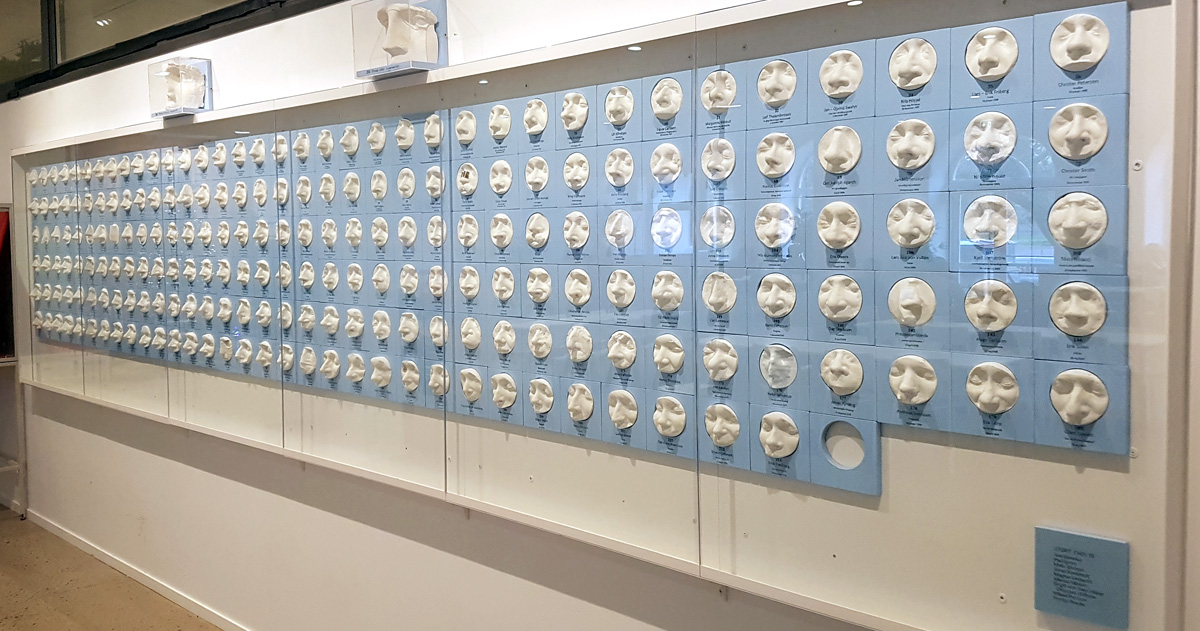
* spex , from spectacle, Latin spectaculum. Student amateur musical theater with music borrowed from opera, musicals, and popular music, with storylines borrowed from literature, history and opera, told as parody. One of Lund’s earliest and most famous spex is Uarda, or the Oracle of the Sphinx (1908).
Most of the following attractions were created by The Uarda Academy, an association of present and former students and carnival performers at Lund’s University. The Uarda Academy was created November 30th, 1958, by Lund’s great personality Sten Broman in connection to the 50th anniversary of the student spex Uarda. Sten Broman served as its Chair, or praeses as it was called, until his death in 1983.
The Uarda Academy’s task is to “work to protect Lund’s spex traditions in combination with innovative productivity.” Many well known humorists have been active within the Uarda Academy, for example, Hans Alfredson, Stellan Sundahl and Johan Wester.
 The sites of the amusing attractions in this visitors’ guide.
The sites of the amusing attractions in this visitors’ guide.
1) Nothingness
One of the more well known amusing attractions in Lund, whose creation was initiated by the Uarda Academy, is the statue Nothingness, located in the middle of Kraft’s Square east of Lund’s Cathedral.
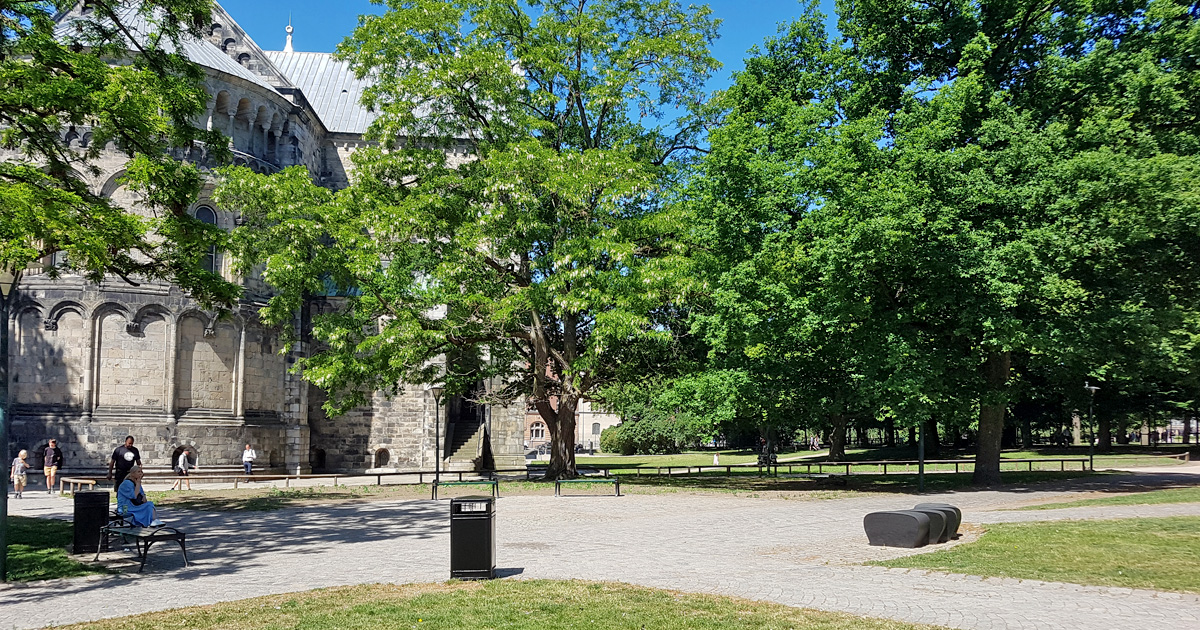 Kraft’s Square, the location of Nothingness.
Kraft’s Square, the location of Nothingness.
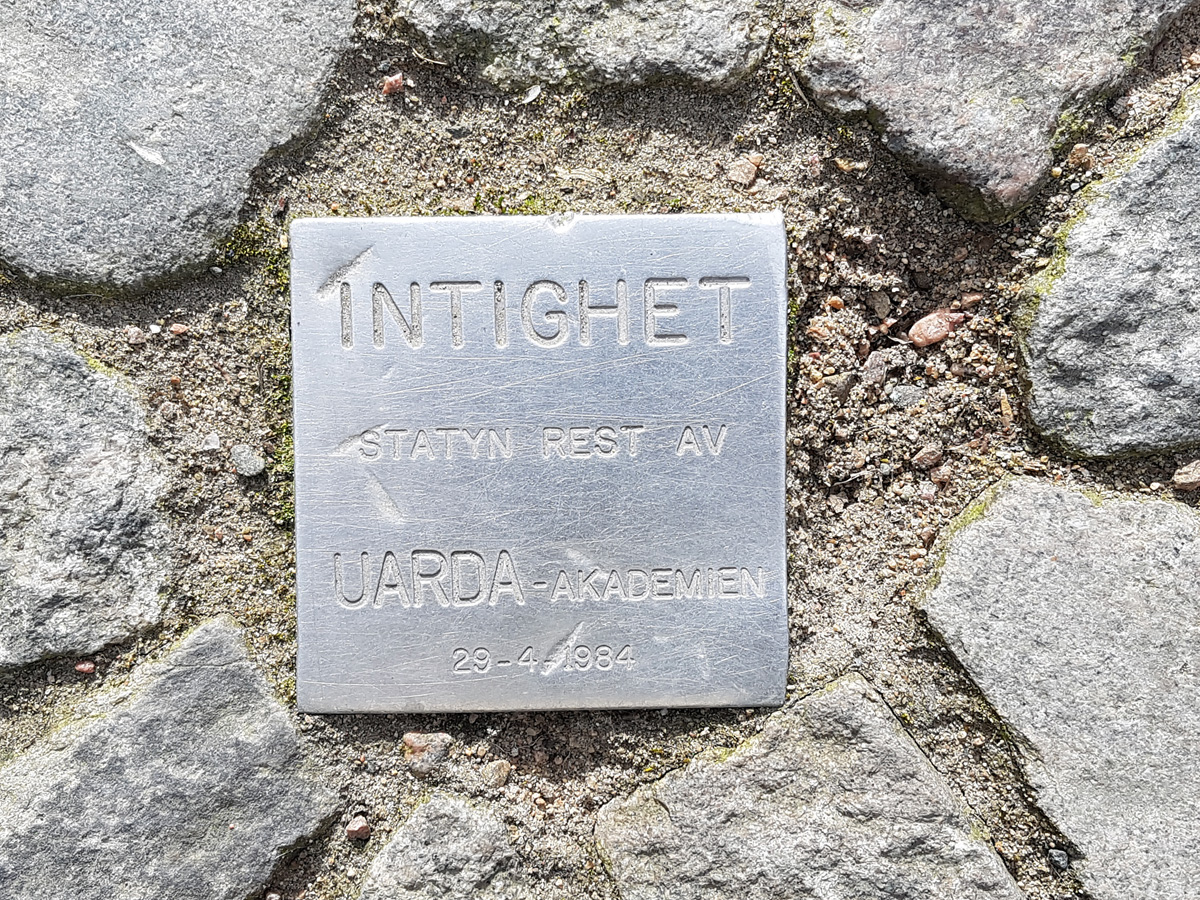 The statue Nothingness, a statue which does not exist.
The long and lively debate whether Kraft’s Square ought to be graced by some kind of statue,
or not, never reached a conclusion. A donation to pay for a statue existed, and one of the
suggestions was a statue of King Canute the Great mounted on a horse because at that time he
was assumed to be Lund’s founder. That suggestion was not sufficiently supported because a
statue of Charles X mounted on a horse already stood in Malmö.
The statue Nothingness, a statue which does not exist.
The long and lively debate whether Kraft’s Square ought to be graced by some kind of statue,
or not, never reached a conclusion. A donation to pay for a statue existed, and one of the
suggestions was a statue of King Canute the Great mounted on a horse because at that time he
was assumed to be Lund’s founder. That suggestion was not sufficiently supported because a
statue of Charles X mounted on a horse already stood in Malmö.
Finally, the Uarda Academy took the matter into its own hands, and April 29th, 1984, the statue Nothingness was dedicated on Krafts Square as a monument over administrative incapability to make a decision.
The statue was thus named because it doesn’t exist; at its site is only the plaque telling that the statue was erected by the Uarda Academy.
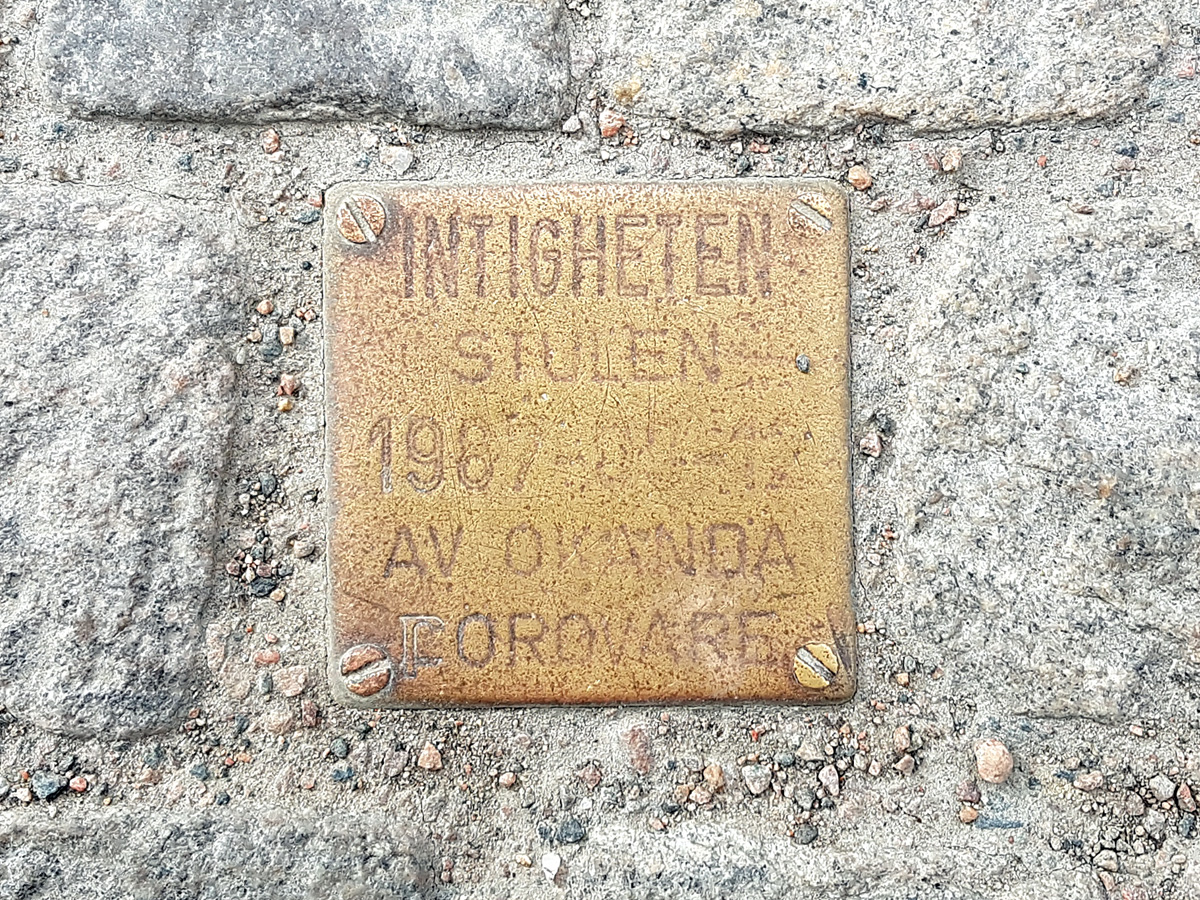 Plaque commemorating the theft of the statue Nothingness.
Over time, other plaques on the same matter appeared at the site. One such plaque was erected
by a group called “If you go to the Academy” whose purpose was to put a top hat on all “If you
go”-statues in Lund, but their meaning is unclear. Their plaque is inscribed “If you go here,
you see nothing.”
Plaque commemorating the theft of the statue Nothingness.
Over time, other plaques on the same matter appeared at the site. One such plaque was erected
by a group called “If you go to the Academy” whose purpose was to put a top hat on all “If you
go”-statues in Lund, but their meaning is unclear. Their plaque is inscribed “If you go here,
you see nothing.”
But the Church decided to remove all plaques except the original one. In connection to the Church’s decision, Nothingness was assumed to be stolen, and a new plaque was installed July 12th, 1987, to draw attention to the theft. Moreover, this plaque calls the statue The Nothingness, not merely Nothingness.
In reality, Nothingness was never lost. Despite its rediscovery, the plaque announcing the theft was allowed to remain. Thus since then, there are two plaques about Nothingness on Kraft’s Square.
2) The Plaque of The Order of the Pea
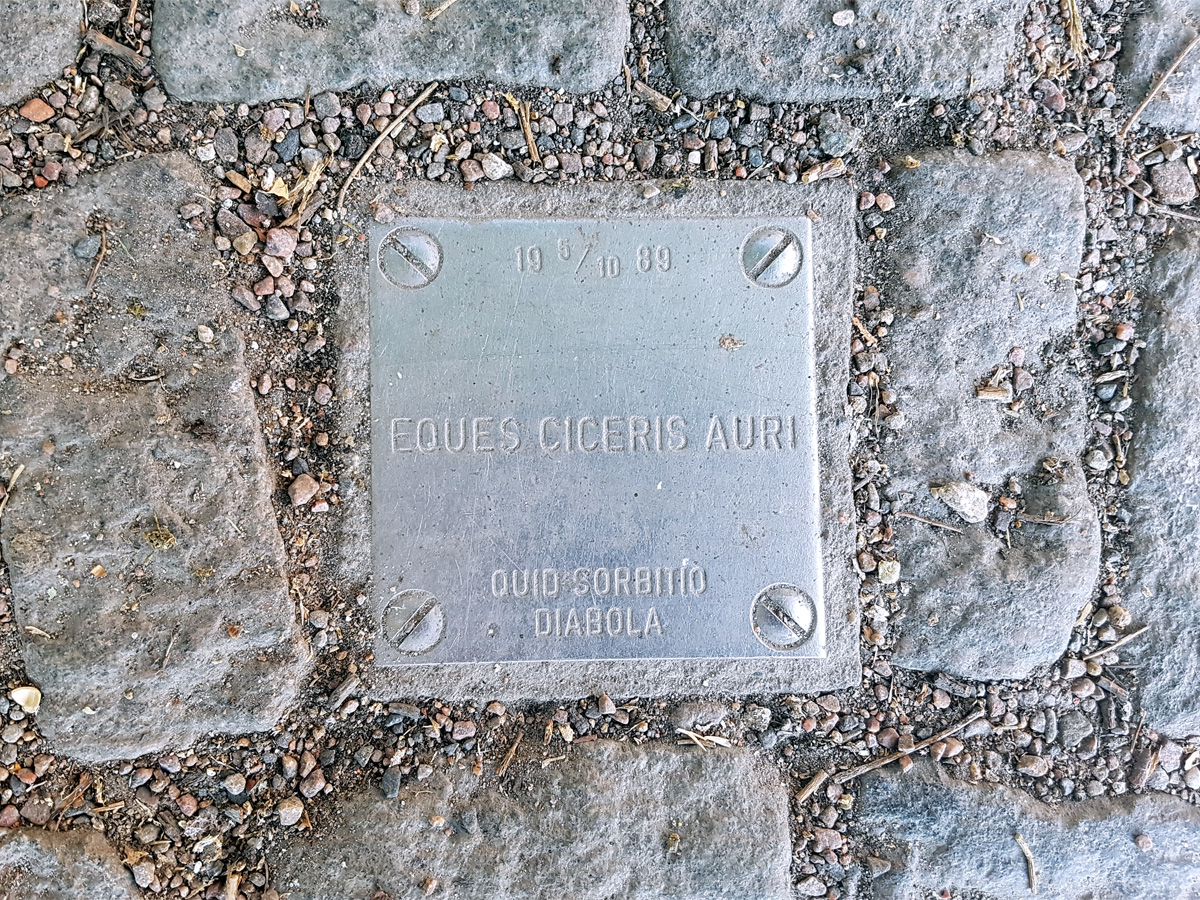 The Order of the Pea plaque.
In the northeastern part of Kraft’s Square, in the middle of its diagonal path, there is also
a plaque located. We don’t know much about it, but since it’s there with its somewhat cryptic
text "eques ciceris auri - quid sorbitio diabola," we had better mention it.
The Order of the Pea plaque.
In the northeastern part of Kraft’s Square, in the middle of its diagonal path, there is also
a plaque located. We don’t know much about it, but since it’s there with its somewhat cryptic
text "eques ciceris auri - quid sorbitio diabola," we had better mention it.
It’s rumored that some friends met to eat pea-soup together and called themselves “The Order of the Pea.” Where they met is unclear, but it could possibly be at restaurant “Rauhrackel.”
Why they installed the plaque, we don’t know. One source reads the text as “Knights of the Golden Pea—what a devilish soup.”
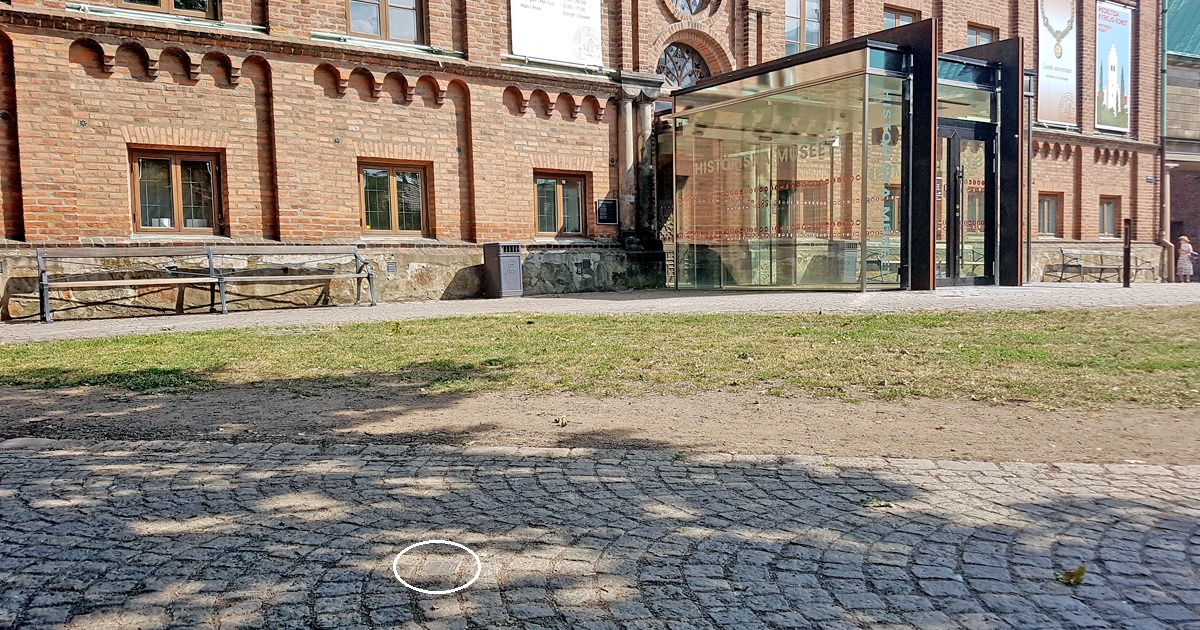 The white circle shows the location of “The Order of the Pea’s” plaque exactly. The Historical
Museum is seen in the background.
The white circle shows the location of “The Order of the Pea’s” plaque exactly. The Historical
Museum is seen in the background.
3) The Pastor’s Wife’s Fall on a Hip*
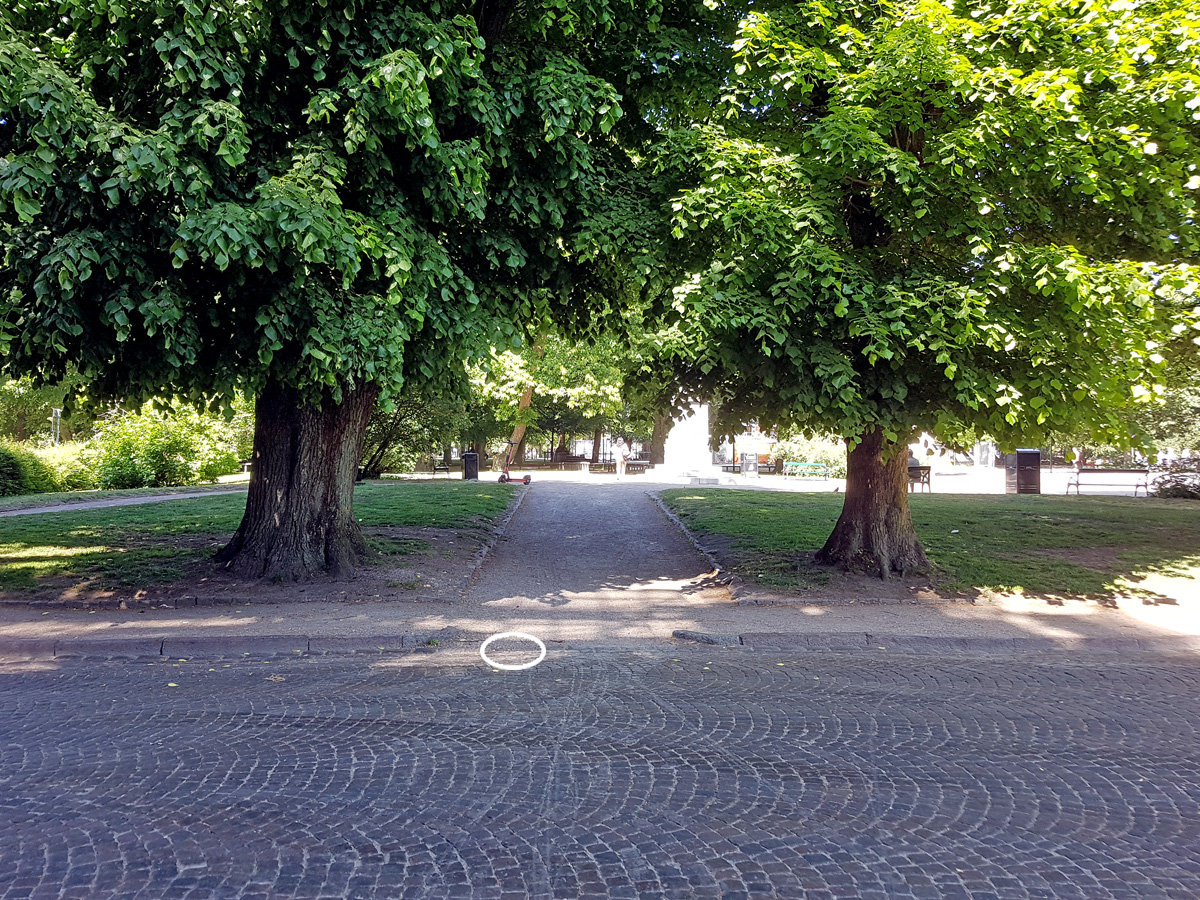 The white circle shows the exact location of the memorial plaque.
On the inside of the edge of the sidewalk by one of the gravel paths on the east side of
Tegnér Plaza there is a memorial plaque that tells about “The Pastor’s wife’s fall on a hip.”
Yet it is not about a wife of any pastor as you may have been led to believe, but just one
more humorous installation here in Lund.
The white circle shows the exact location of the memorial plaque.
On the inside of the edge of the sidewalk by one of the gravel paths on the east side of
Tegnér Plaza there is a memorial plaque that tells about “The Pastor’s wife’s fall on a hip.”
Yet it is not about a wife of any pastor as you may have been led to believe, but just one
more humorous installation here in Lund.
A group of 6-7 friends used to exercise every Thursday in Skrylle east of Lund. One was called “Pastor” because of his “somewhat monotonous and moralistic sermonizing.” After exercise, they used the sauna, ate pea-soup, and drank beer and punch, hosting the gathering used to rotate among the friends.
One late evening, the “Pastor’s” wife fell in Lundagård and fractured her hip, and the “Pastor” claimed a paving stone caused the fall. His friends felt skeptical, and afterwards it was difficult to determine exactly where it happened.
They approximated where the fall took place and there installed a memorial plaque.
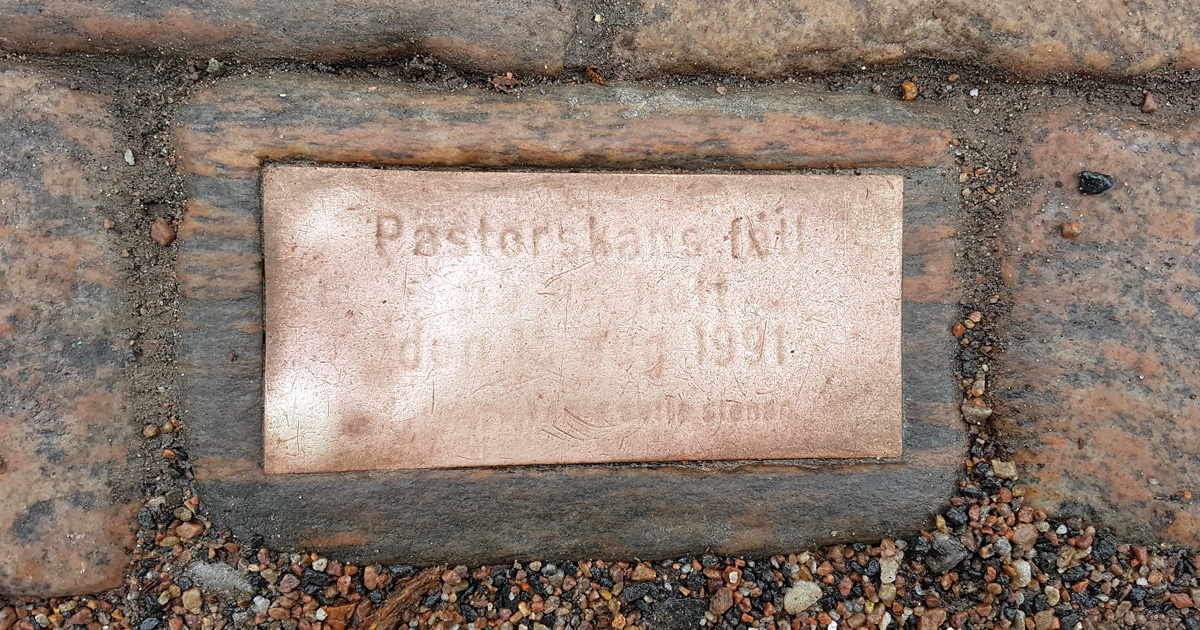 Memorial plaque over the “Pastor’s” wife’s fall on a hip.
Memorial plaque over the “Pastor’s” wife’s fall on a hip.
Nowadays, it’s difficult to read the text, but it says, “The Pastor’s Wife’s Fall on a Hip, August 15th,1991—the joggers installed the stone.”
* This anecdote is an example of what translations of books by P.G. Woodhouse are full of, namely, “untranslatable word play” or puns. “På en höft” literally means ”on a hip.” But in Swedish, it also is an expression of “approximately,” “circa,” “around,” or “about.” So the poor woman actually fell on her hip, and the marker is placed approximately where she fell. The inscription includes a second pun: “springpojkarna” literally means “messenger boys,” but it can also mean “joggers.” Finally, “satte stenen” (“placed the stone”) is an expression typically found last on runestone inscriptions.
4) The Nosoteque
The Nosoteque
Café Athen, free entrance
weekdays during semesters
See also
• The Nosoteque website
(only in Swedish)
The Nosoteque holds a collection of plaster-casts of prominent people’s noses and is located
at Café Athen in the AF-Stronghold. In June, 2016, the British newspaper The Guardian named
The Nosoteque one of Europe’s ten oddest attractions.
At the moment, The Nosoteque holds almost 200 nose-casts, of for example: former Prime Minister Ingvar Carlsson, the humorists Stellan Sundahl, Johan Wester and Anders Jansson, food- and wine connoisseur Carl Jan Granqvist, Sweden’s first woman Bishop Christina Odenberg, and Sweden’s first astronaut Christer Fuglesang. Nose-casts of people long dead also exist, made from statues of these famous people, for example, Esaias Tegnér, Tycho Brahe, Carl von Linné, and Fritiof Nilsson Piraten. The list over nosified people is called the Diarium Nasale or the First Book of Noses; the list is found at the Nosoteque website (only in Swedish).
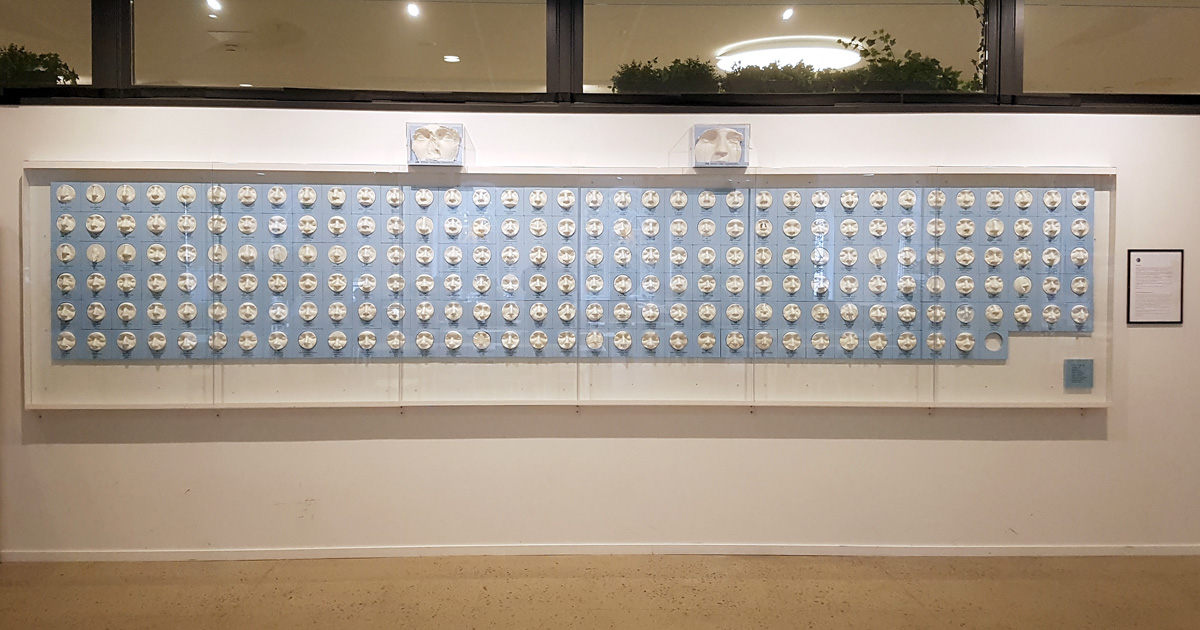 The complete set of nose-casts in Café Athen, AF-Stronghold.
The complete set of nose-casts in Café Athen, AF-Stronghold.
The Nosoteque was founded by the humorist Hans Alfredson. He got the idea on the way from Stockholm to Lund when his train reached Nässjö. We may suspect that he read its name as Näs Sjö (“Nose Lake”). He shared his idea in a speech at the 1968 November Last festivities in AF’s Small Hall, thanking the Academic Society for installing him as an honorary member.
Hans Alfredson suggested that the Academic Society ought to make plaster casts of prominent persons’ noses as a way of remembering them. The casts should then be affixed to the ceiling in the Small Hall, so after some years it would resemble a stalactite cave. That way, the academics of former years would be able to thumb their noses at the young freshmen sitting below.
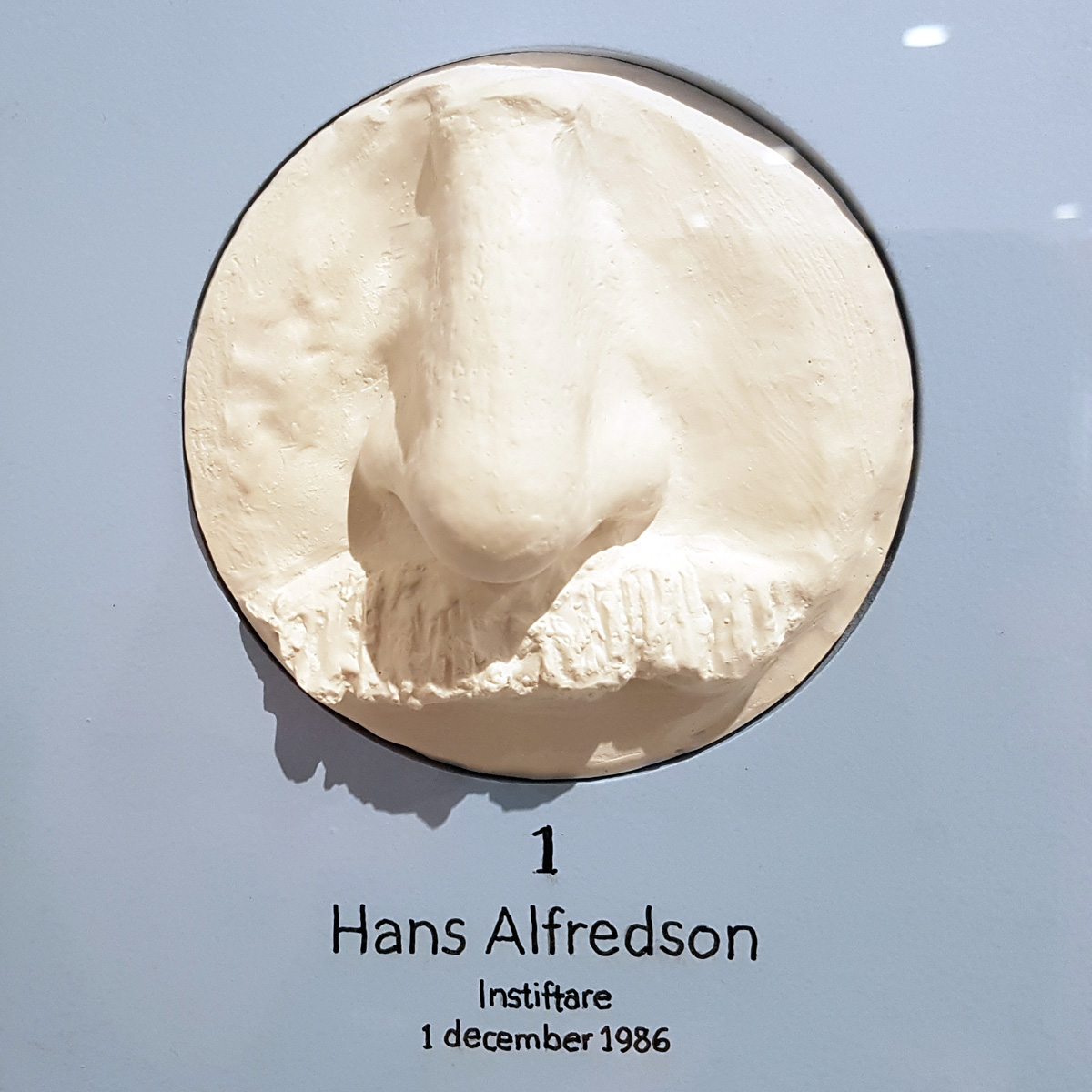 Nose number 1. A cast of Hans Alfredson’s nose.
His proposal was so well received that when he returned to Stocckholm, he let three nose casts
be made—his own and those of two former spex-collegues. In connection to April Last 1987, the
Academic Society constituted its “Nasal Committee.” And December 1st, 1987, the Nosoteque was
dedicated and Hans Alfredson’s nose-cast was unveiled. By then, the Nosoteque already included
30 nose-casts.
Nose number 1. A cast of Hans Alfredson’s nose.
His proposal was so well received that when he returned to Stocckholm, he let three nose casts
be made—his own and those of two former spex-collegues. In connection to April Last 1987, the
Academic Society constituted its “Nasal Committee.” And December 1st, 1987, the Nosoteque was
dedicated and Hans Alfredson’s nose-cast was unveiled. By then, the Nosoteque already included
30 nose-casts.
For many years, the Nosoteque was housed in the tower room of the Academic Stronghold, but in connection to November Last celebrations 2005, it was moved to the recently opened Café Athen. December 1st, 2022, the new showcase holding all of the Nosoteque’s casts was dedicated.
The process of making nose-casts is called nosification and is carried out by members of the Nasal Committee, which also is in charge of the Nosoteque. The nosification only takes a few minutes and is preferably carried out at an official event. It ought to come as a total surprise for the chosen person. Members of the Nasal Committee are dressed in white robes, ornamented by a nose in profile. The person, or people, executing the nosification is called snout-master, and the person installing the cast is the schnozzle operator.
The mold is made from alginate, in which a plaster cast of the nose is made. After the nosification, the chosen person receives a shot of cognac and the Committee’s lapel pin in the form of two nostrils. The nosified also receives the Nasal Committee’s Book of statutes and its songbook, the Nasalmbook.
5) The Academic Quarter Hour
At the edge of the lawn on the eastern side of the fountain on University Plaza, a plaque shows “the meridian of the academic quarter hour.” To understand its meaning, we had better define “academic quarter hour.”
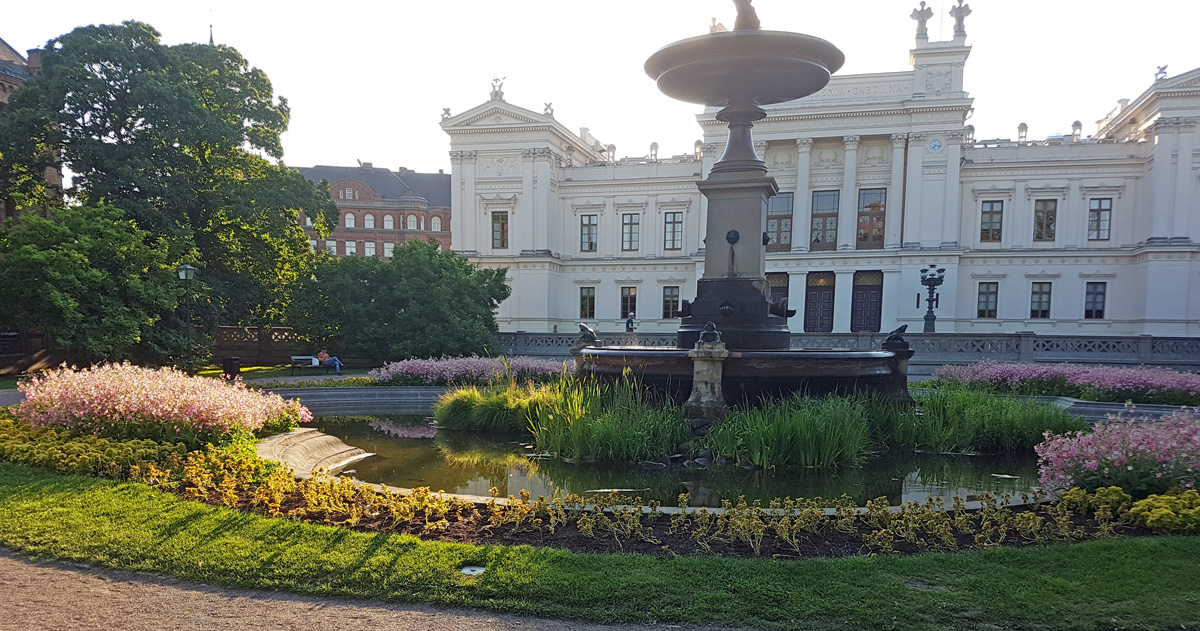 The plaque showing “the meridian of the academic quarter hour” at the edge of the lawn of
Lund’s University Plaza.
The plaque showing “the meridian of the academic quarter hour” at the edge of the lawn of
Lund’s University Plaza.
In the olden days, students rarely owned a watch. Instead, they listened to the Cathedral bells toll the hours to know when it was time to go to class. Since classes began a quarter past the tolling, students had time to make it to class. After 6 p.m., the students were expected to change into evening wear, so then a “double-quarter” applied.
Nowadays, when everybody owns a watch, the “academic quarter” isn’t needed any longer, but it remains for tradition’s sake. In Lund, the “academic quarter” is still valid for many subjects and other academic events. When the “academic quarter” isn’t valid, customarily the time for class or events is followed by the word “dot” or a period-sign. After 6 p.m., time is followed by “dot, dot” when the “academic double-quarter” isn’t valid.
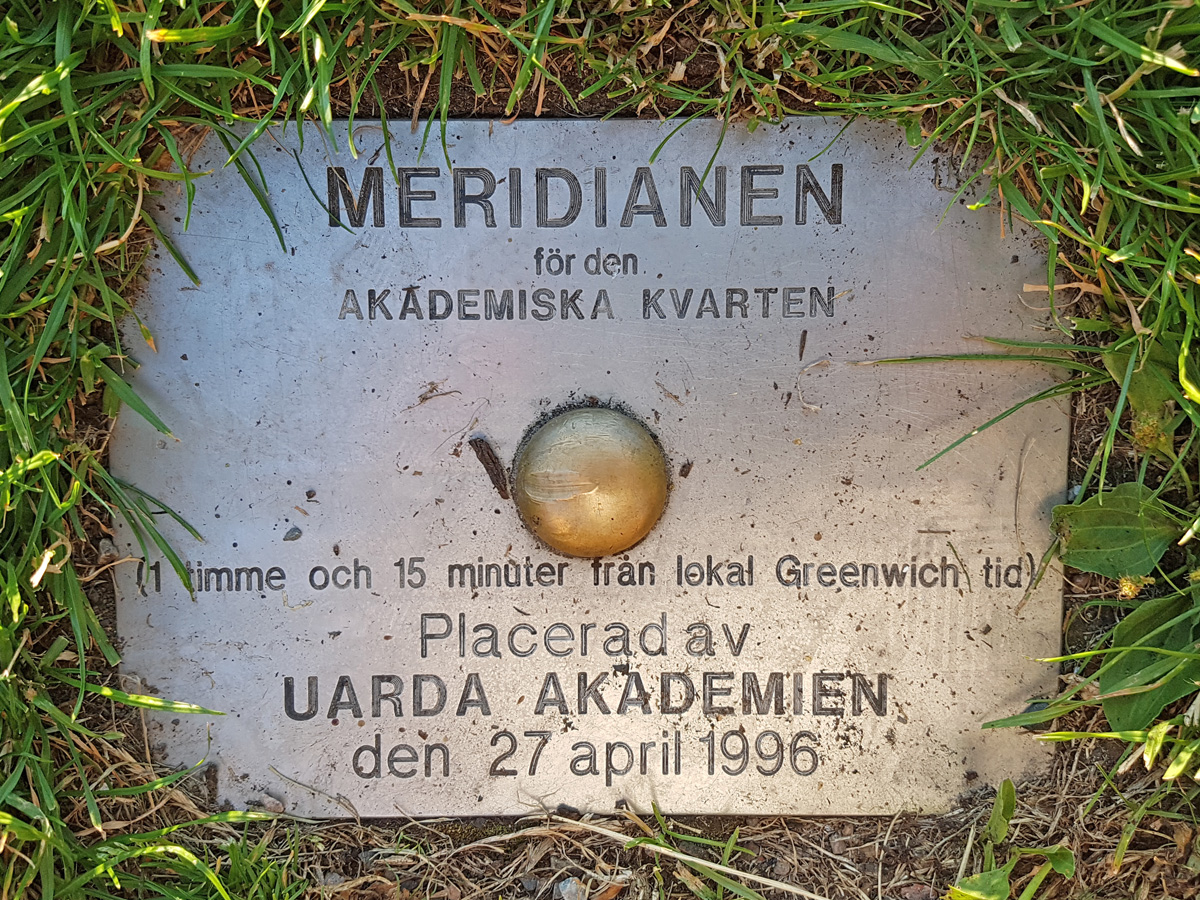 The meridian for the academic quarter, transplanted from Greenwich, London.
In the beginning of the 1990s, The Uarda Academy wanted to bring order to students who
customarily arrived late for lectures. Despite the custom of both the “academic quarter” and
the “double quarter,” some students, it was rumored, arrived so late that their lectures were
already over. To solve the problem, the Uarda Academy sent an expedition to Greenwich, London,
to dig up a piece of the meridian, which on return they “transplanted” as a meridian for the
academic quarter in Lund. On April 27th, 1996, the dug-up piece of the Greenwich meridian was
placed on the eastern side of the fountain on University Plaza. Then, it was marked as “the
meridian for the academic quarter.”
The meridian for the academic quarter, transplanted from Greenwich, London.
In the beginning of the 1990s, The Uarda Academy wanted to bring order to students who
customarily arrived late for lectures. Despite the custom of both the “academic quarter” and
the “double quarter,” some students, it was rumored, arrived so late that their lectures were
already over. To solve the problem, the Uarda Academy sent an expedition to Greenwich, London,
to dig up a piece of the meridian, which on return they “transplanted” as a meridian for the
academic quarter in Lund. On April 27th, 1996, the dug-up piece of the Greenwich meridian was
placed on the eastern side of the fountain on University Plaza. Then, it was marked as “the
meridian for the academic quarter.”
At 2 p.m., all watches were synchronized by moving them forward by fifteen minutes. Thereby, time in Lund was synchronized and unified, so henceforth all students could be on time and still be sure to be fifteen minutes late.
The text of the plaque of the academic quarter might suggest that it is placed exactly one hour and fifteen minutes from Greenwich. A calculation from the position of the plaque, however, indicates that it is placed one hour, three minutes, and forty seconds from Greenwich time.
6) ”Lagom” = Just Right
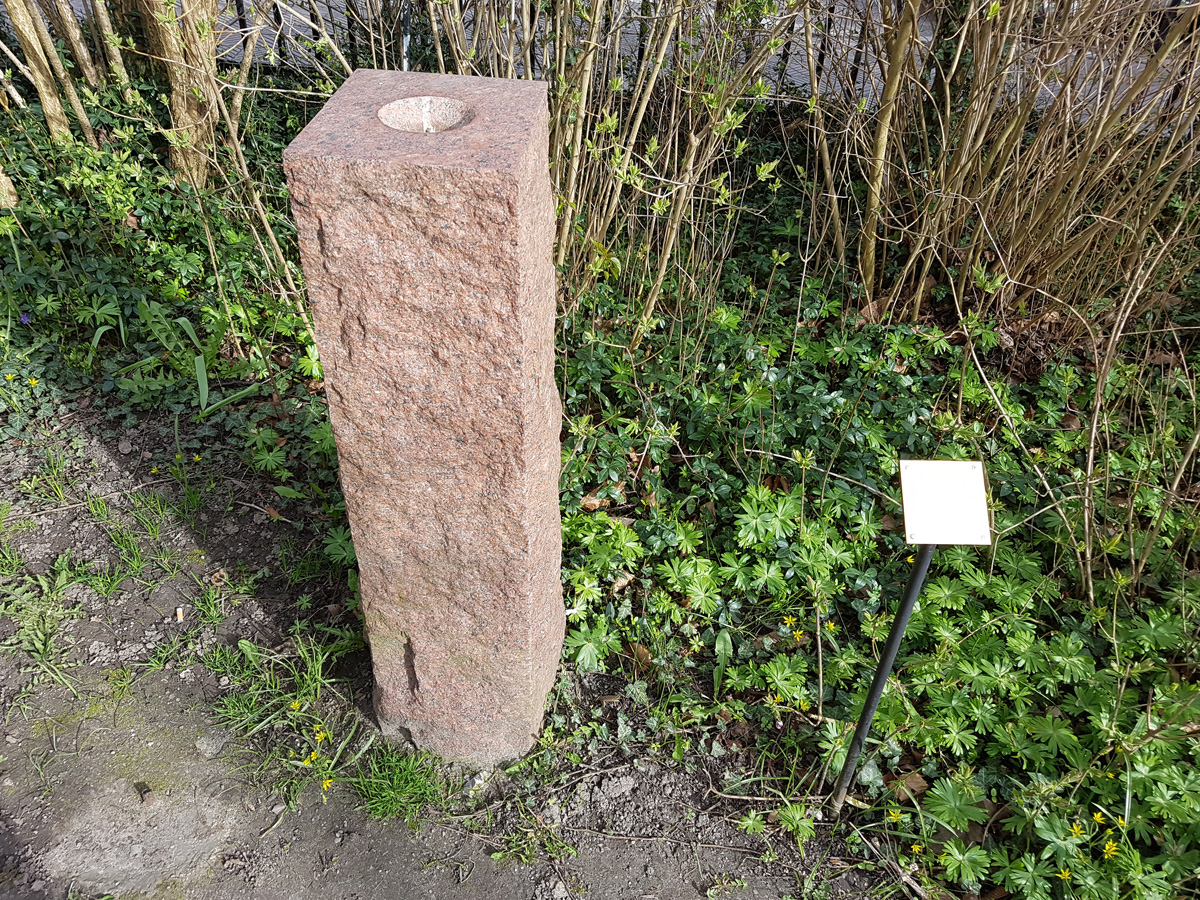 Uarda Academy’s international measurement unit for ”lagom.”
The Swedish word ”lagom” may be difficult to understand, not least for people from other
countries. On April 29th, 1992, to bring clarity to “lagom,” the Uarda Academy dedicated a
reference measure, which they call the international measurement unit for lagom, abbreviated
lgm.
Uarda Academy’s international measurement unit for ”lagom.”
The Swedish word ”lagom” may be difficult to understand, not least for people from other
countries. On April 29th, 1992, to bring clarity to “lagom,” the Uarda Academy dedicated a
reference measure, which they call the international measurement unit for lagom, abbreviated
lgm.
The reference measure consists of a bowl shaped indentation in red Vånga granite,and is thought to hold three shots of aquavit because “it is lagom,” neither too much, nor too little.
The original sign was stolen, so in connection to its rededication a new sign was erected. At the same time, a control measurement was made to check that the unit had not eroded due to severe weather. The control showed a volume of 15 cl, or 1 lgm, identical to its original measure.
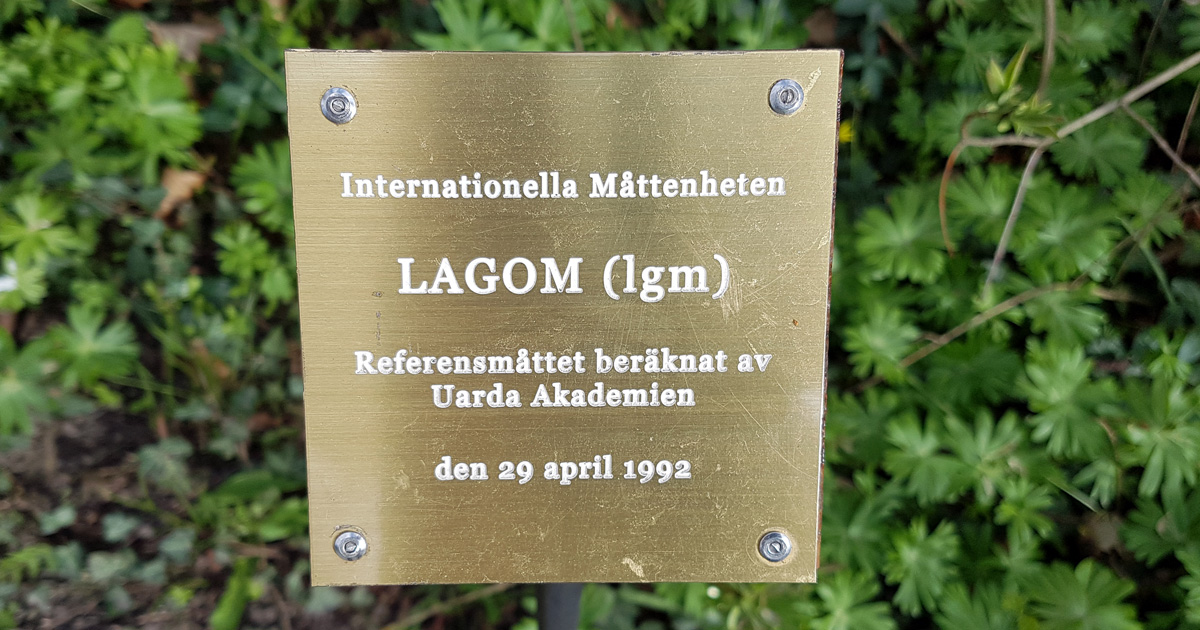 The Plaque of the International Measure Unit for “Lagom”
The Plaque of the International Measure Unit for “Lagom”
Memorials over the first and second disembarkation in Lund
Other amusing attractions are not located in central Lund. To see them requires a three km (not quite two miles) bike ride from center city. You may rent one of the pubic bicycles—more of that on our travel information page. You can also take Skånetrafikens city bus to Värpinge village.
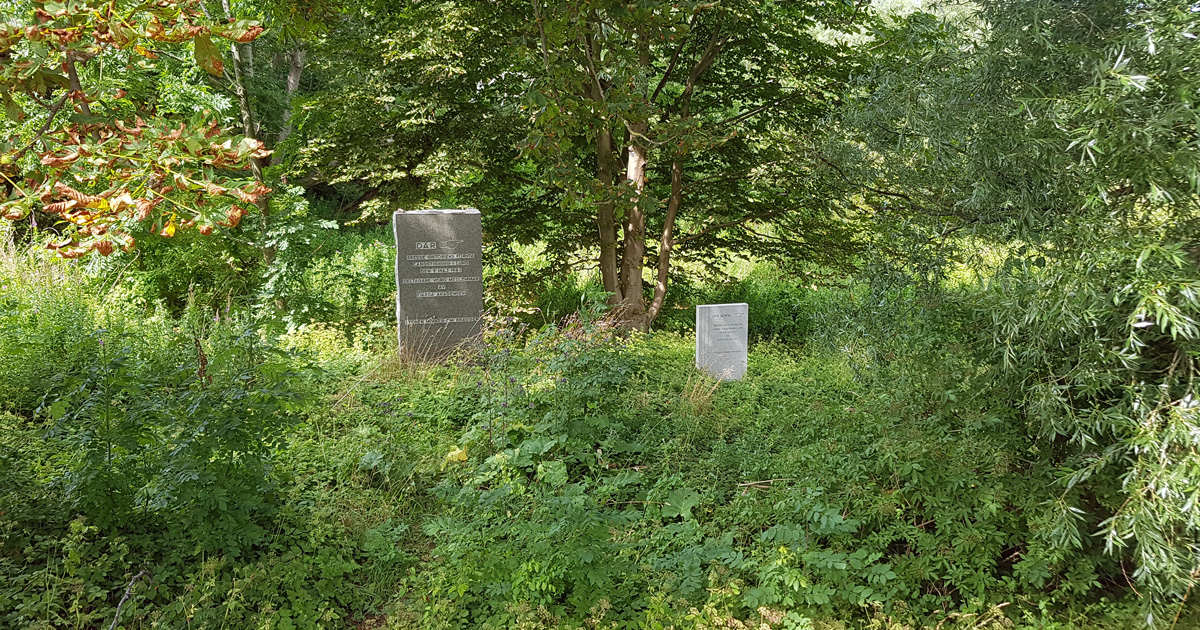 Memorials over the first and second disembarkation in Lund.
Memorials over the first and second disembarkation in Lund.
Lund is not a coastal city, so it lacks a harbor. In 1965, however, Sten Broman, præses of the Uarda Academy, decided to prove that it is possible to reach Lund by water. So he travelled along Höje stream from Lomma on the coast to Värpinge, located at Lund’s city limit. Thus, the Uarda Academy succeeded in making the first disembarkation at Lund in world history.
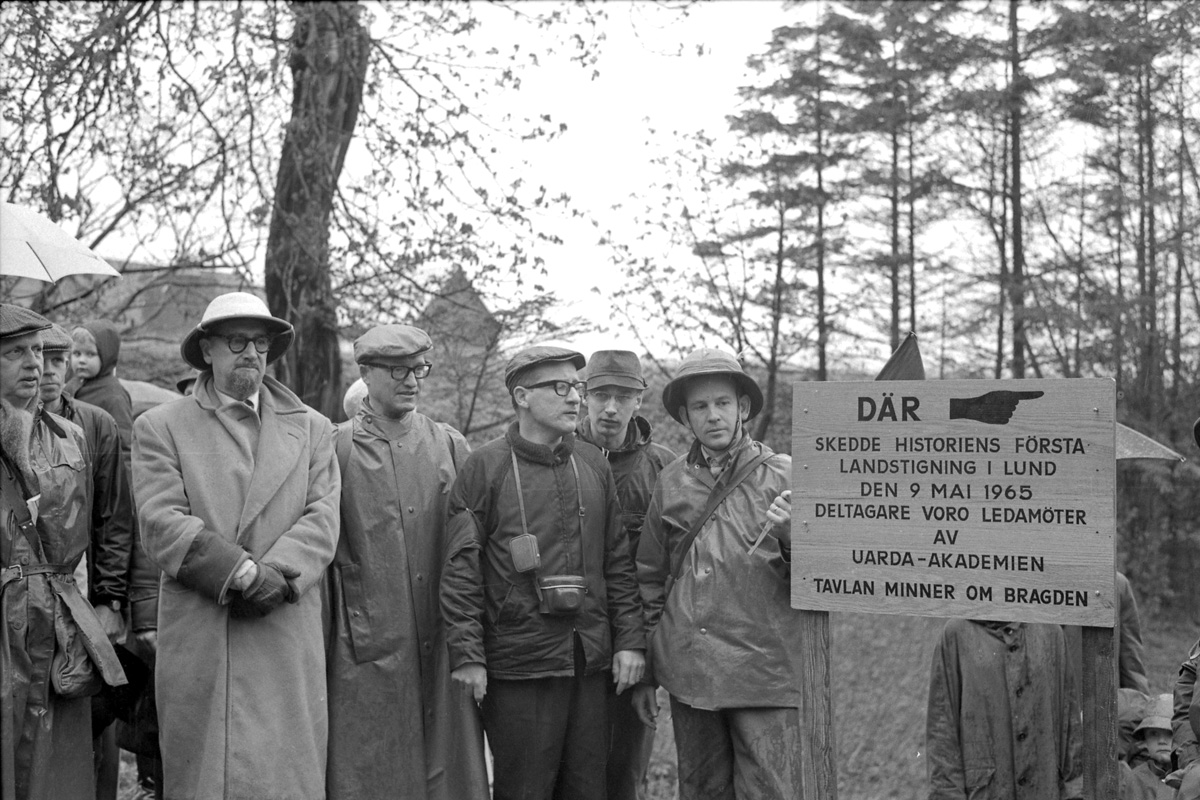 Sten Broman and members of the Uarda Academy after completing the disembarkation in 1965.
Travelling in a rowboat, the journey began in Lomma’s harbor at 10:04 a.m., May 9th, 1965.
Sten Broman, drinking punch, wore a yellow coat and a pith helmet. Povel Ramel also attended
and filmed the feat. Sten Broman’s friends from the Uarda Academy walked on both sides of the
stream and dragged the boat using ropes, since the stream was too narrow for the use of oars.
Sten Broman and members of the Uarda Academy after completing the disembarkation in 1965.
Travelling in a rowboat, the journey began in Lomma’s harbor at 10:04 a.m., May 9th, 1965.
Sten Broman, drinking punch, wore a yellow coat and a pith helmet. Povel Ramel also attended
and filmed the feat. Sten Broman’s friends from the Uarda Academy walked on both sides of the
stream and dragged the boat using ropes, since the stream was too narrow for the use of oars.
They arrived at the bridge in Värpinge just inside Lund’s city limit, and there they stopped because the shallow water prevented further progress. The weather was lousy, rainy and cold, and the eight km (almost five miles) journey took five hours to complete.
A Memorial commemorates the disembarkation. However, it is raised on the western side of the bridge on private land belonging to the neighboring district of Staffanstorp. The area east of the bridge, belonging to Lund, where the disembarkation actually occurred, is a nature reserve where non-official signs and markers are forbidden.
A group of academics from Stockholm, called the Royal Envoys, with no connection to the Uarda Academy, decided to repeat the feat fifty years later. They acted with the approval of the Uarda Academy, some of whose members were present to witness the event and hand out diplomas on its completion. At 10:04 a.m. May 9th, 2015, exactly fifty years after the first disembarkation, the Royal Envoys set off from Lomma. Höje Stream was considerably more overgrown than fifty years previously, and the current was strong. But they persisted and succeeded in making the second disembarkation at Lund in world history.
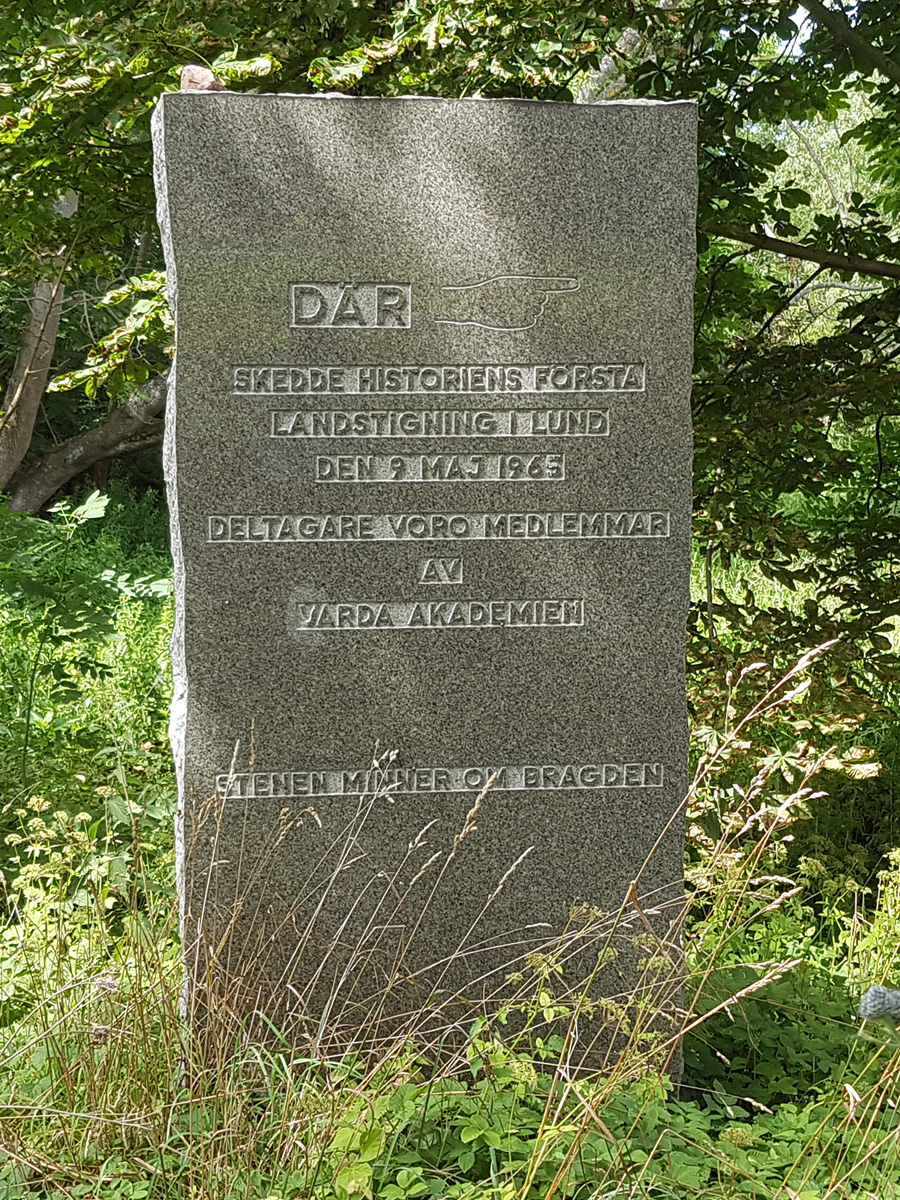
|
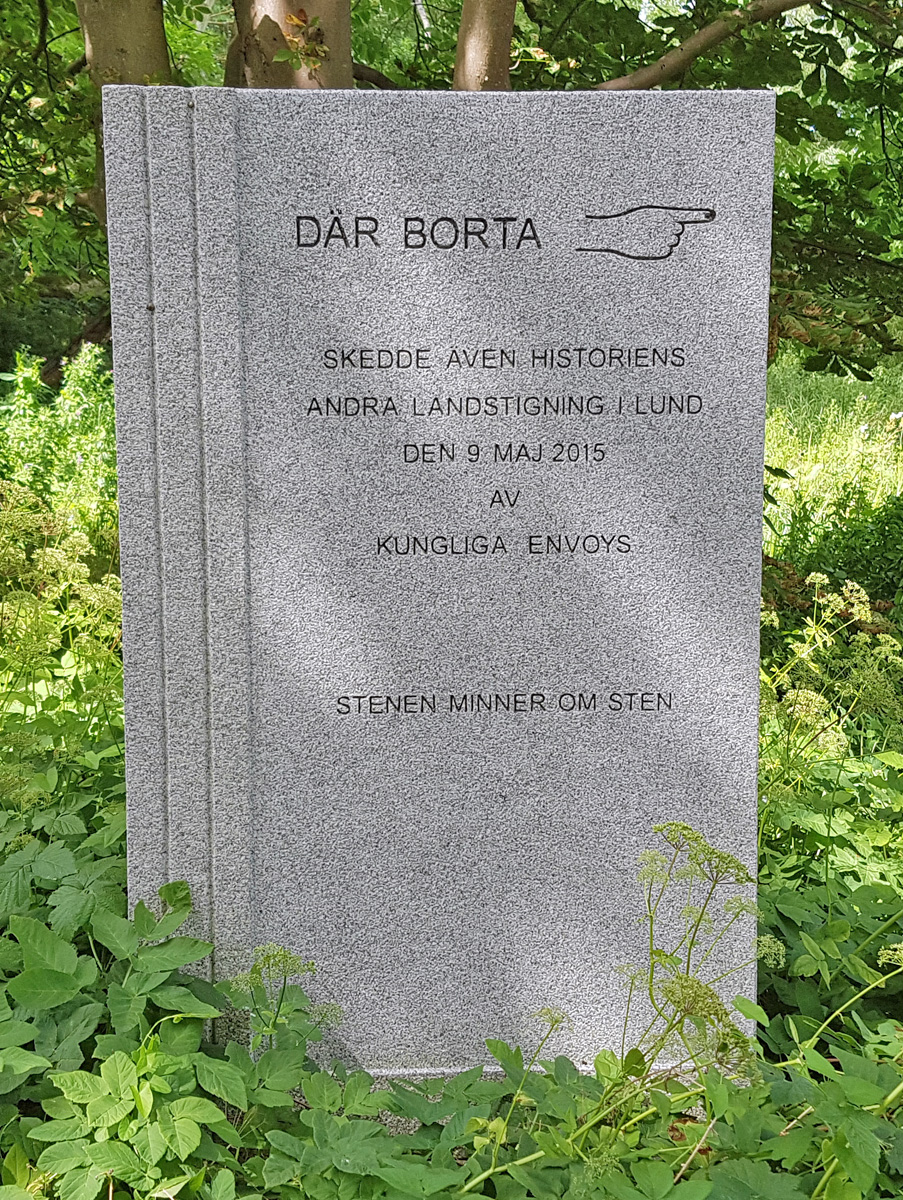
|
| Memorial over the first disembarkation in Lund. | Memorial over the second disembarkation in Lund. |
Memorial inscription over the first disembarkation in Lund: There [hand pointing right] occurred history’s first disembarkation in Lund 9 May 1965 Participants were members of the Uarda Academy—the stone reminds us of the deed.
Memorial inscription over the second disembarkation in Lund: Over There [hand pointing right] occurred history’s second disembarkation in Lund 9 May 2015 Participants were the Royal Envoys - the stone reminds of Sten (stone).
![[Bild]](/common/img/default.png)